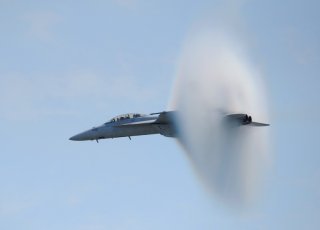This Silicon Valley Startup Could Design an Unmanned Supersonic Plane for the Air Force
The U.S. Air Force awarded a small business innovation research contract to Exosonic, Inc. to develop a "low boom" supersonic demonstrator.
Supersonic unmanned aerial vehicles (UAVs) can help combat pilots during training by acting as a near-peer adversary fighter, but sonic booms present an obstacle for these exercises. The U.S. military is looking for ways to reach supersonic speeds without the accompanying noise.
The shock waves created by an object moving faster than the speed of sound creates an ear-splitting noise that a person on the ground hears. The shock front from sonic booms can approach 100 megawatts per square meter, while the sound may exceed 200 decibels, and an unusual cloud can even form in the wake of the aircraft.
This month, the U.S. Air Force awarded supersonic transport company Exosonic Inc. a Direct to Phase II Small Business Innovation Research (SBIR) contract award which will fund the development of a low boom supersonic UAV demonstrator. The contract was awarded by the Air Force Life Cycle Management Center’s AFWERX in partnership with Air Combat Command and the Air Force Research Laboratory, as well as the Presidential and Executive Airlift Directorate.
Exosonic will work to develop the first purpose-built supersonic UAV to aid the Air Force in its pilot training mission, and will utilize technologies relevant to the company’s quiet supersonic airliner. Exosonic, an aerospace startup founded in June 2019 and headquartered in San Francisco, announced that it plans to reinvest the profits from UAV sales to fund future supersonic product developments, such as its proposed airliner.
“Our vision at Exosonic is to fly people supersonic everywhere with our airliner designed to fly supersonic overland with a muted sonic boom,” said Norris Tie, Exosonic’s CEO in a company blog post. “The supersonic UAV work is critical to our company’s strategy due to how much we’ll learn about designing, manufacturing, and maintaining supersonic airplanes with our first UAV products. The UAV is also important to our company’s longevity. It will provide profits that we can funnel back into our company and give investors, suppliers, and customer’s confidence that we can deliver supersonic aircraft to the market before anyone needs to make a multi-billion dollar investment.”
Training Platform
The goal of the project is to develop the supersonic UAV that could be used to aid pilot training missions by acting as a near-peer adversary fighter to challenge fighter pilots in live flight training. Due to constrained training budgets and a pilot shortage, the Air Force cannot efficiently produce new, fully-trained fighter pilots, and as a result, a limited number of fighter pilots are receiving the adequate amount of live air training necessary to be prepared to defend our country against near-peer adversaries.
This is where Exosonic’s supersonic UAV could fill an important void. It will serve as a mock adversary to test fighter pilots in live flight training exercises.
According to the company, the UAV will be equipped with various payloads and sensors, while training could be conducted at a fraction of the cost of existing live air training solutions. That could result in the savings of millions in training dollars while also reducing wear and tear on existing Air Force aircraft that serve as aggressors. The supersonic UAVs will also enable fighter pilots to focus their flight time on blue air training instead of flying as the enemy for their fellow pilots.
In addition to working with the Air Force, Exosonic is also engaging with government contractors, including Tactical Air Support to understand how pilot training can be improved.
“Tactical Air Support is excited to see an emerging supersonic UAV platform that can operate jointly with a piloted contract adversary like the Tactical Air Support F-5 Advanced Tiger,” said Jim DiMatteo, director of communications for Tactical Air Support and F-5 ADAIR pilot in the Exosonic blog post. “These expanded capabilities will significantly enhance the DoD Blue forces training at a reduced cost.”
Exosonic has also received support from lawmakers in California.
“I’m pleased to support Exosonic’s recent proposal to AFWERX to develop a low boom supersonic UAV,” said Rep. Ted Lieu (D-Calif.) in the Exosonic blog post. Lieu serves as California’s 33rd congressional district representative.
“Their supersonic UAV could be a cost-effective way to train future pilots and would help further flight innovation by demonstrating quiet supersonic overland travel with a muted sonic boom,” Lieu said. “I look forward to seeing Exosonic field its capabilities as the small business becomes a new player in California’s supersonic aviation industrial base.”
Peter Suciu is a Michigan-based writer who has contributed to more than four dozen magazines, newspapers and websites. He regularly writes about military small arms, and is the author of several books on military headgear including A Gallery of Military Headdress, which is available on Amazon.com.
Image: Reuters.

